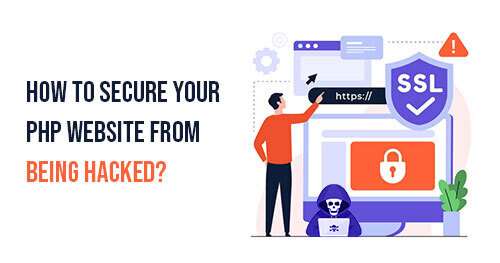
PHP Website Security Issues and Ways to Secure it from Hackers
PHP is the world's most popular website programming language; hence, it is frequently probed as an attack surface by malicious parties. If you, too, own a PHP website, learn different ways to secure it from all the vicious attacks with our blog!
The reason for the popularity of the PHP language is its easy coding structure and developer-friendly functions. Different PHP websites share parts of their code with other web applications. If a shared piece of code is infected, it compromises the website. Also, it may face different hacking attacks because of the loopholes that go unnoticed while developing a website.
So! This blog is for all those who wonder how to make a PHP website more security">secure. It concerns some PHP security best practices you could use wisely in your projects.
This PHP website security checklist ensures your website is always well protected and stands out from any external web attacks. Continue reading to check it out!
Cross-Site Scripting (XSS)
Cross-site scripting is an attack where an attacker injects malicious executable scripts into the code of a trusted website. Usually, the attacker initiates this attack by sending a malicious link to a user and enticing the user to open it. For example, an attacker inserts trojan code into the website.
The injected malicious attack replaces the original code of your website and works as actual code to steal your website's data. Hackers get access to your cookies, sessions, and history.
Counter- Shield
It would be best to use HTML special characters and ENT_QUOTES while programming code for your website. It ensures PHP website security. Also, when you use ENT_QUOTES, you should remove the single and double quote options.
Cross-Site Request Forgery (CSRF)
It is an attack where an attacker tricks the user into executing actions that are otherwise unwanted on a web application for which they're currently authenticated. For example, Mr. Alex wishes to transfer $10 to Mr. Raj using the bank.com web application, which is vulnerable to CSRF. An attacker tricks Alex into sending the money to him instead by building an exploit URL or executing the action with social engineering.
Counter-Shield
The CSRF attack happens only when you click on the malicious link sent. So! You should use two protective measures against this attack:
- Use the GET requests in your URL and ensure that the non-GET requests are generated only from your client-side code.
Session Hijacking
Here, the attacker takes control of a web user's session by secretly obtaining the session ID and masquerading as the authorized user. For example, you get an email about your favorite online brand. You click the link (which contains an attacker's session key) to start shopping. The attacker gains access to your entire session.
Counter-Attack
You should always bind your sessions to the desired website's IP address.
SQL Injection Attacks
SQL injection attacks are for the database. Here, the hacker wants to access your database to view or modify it. The attack is usually done by using web form fields. Hackers alter those fields and queries to get control of the application database. For example, hackers used SQL Injection attacks to compromise 130 million credit and debit card numbers (Heartland Payment Systems).
Counter-Attack
It would be best if you used parameterized queries. These PDO queries prepare and execute an SQL statement in a single function call. It substitutes the arguments before running the SQL query and prevents an attack.
Key Recommendations from Innoraft
Here are two key tips about PHP website security from Innoraft:
- It would be best to always use SSL Certificates for end-to-end secured data transmission over the Internet. HTTPS (hypertext transfer protocol secure) is a globally recognized protocol to transmit data between servers securely. Your application will remain safe over the Internet.
- You must hide files from the browser. You can use a specific directory structure in the micro PHP frameworks to ensure the storage of essential framework files like the configuration file (.yaml), etc. You should store your files in a public folder. Please don't keep them in the root directory. It makes them less accessible in the browser and saves you from a security breach of the application.
Conclusion
PHP, a widely used server-side programming language, is vulnerable to security threats. However, it offers unique websites with high reliability and security when dealt with properly.
We at Innoraft encourage you to take advantage of the latest versions of PHP because they come with more secure features and offer better performance. It is faster with CodeIgniter, syntax requires less code, and security is optimized.





